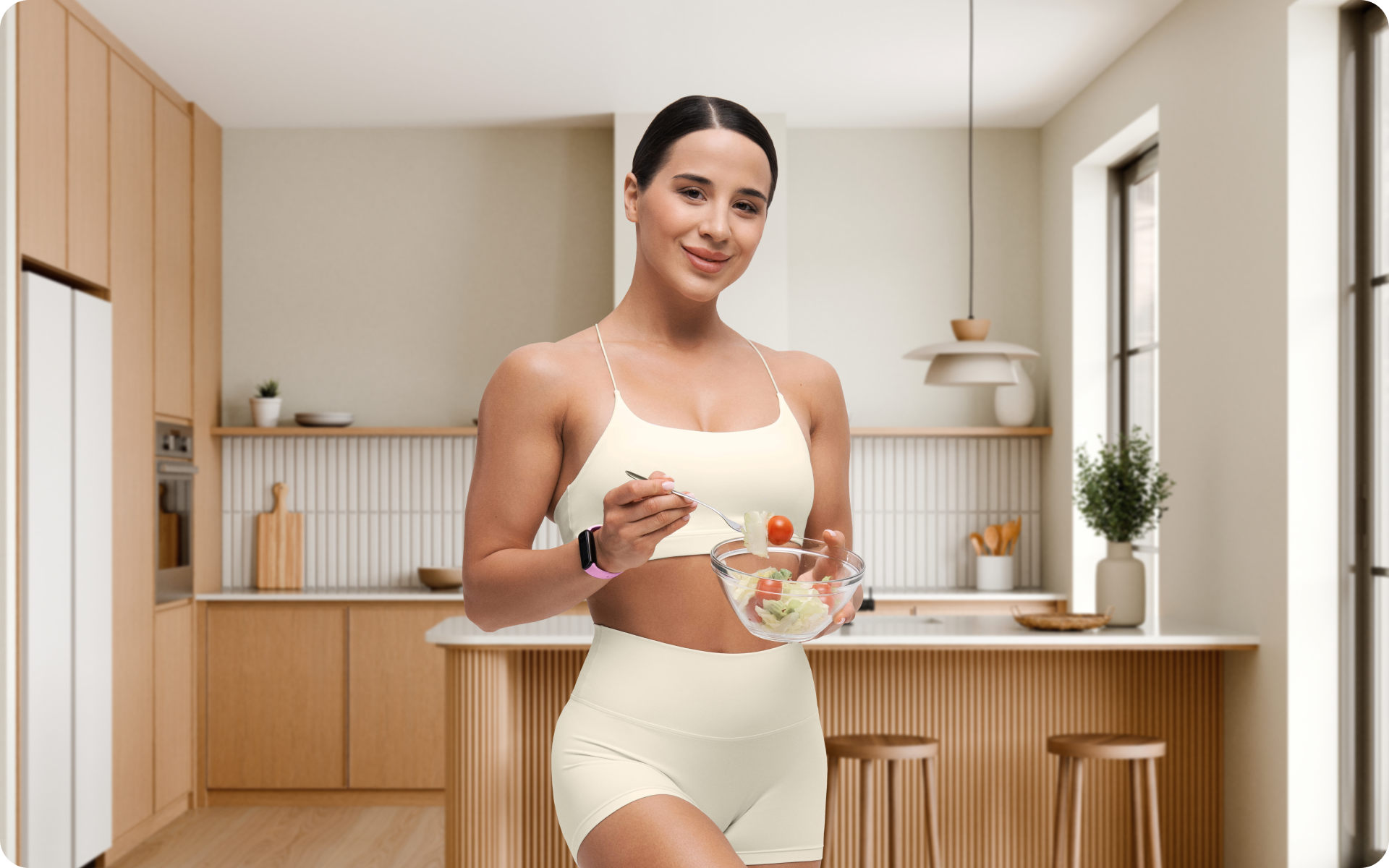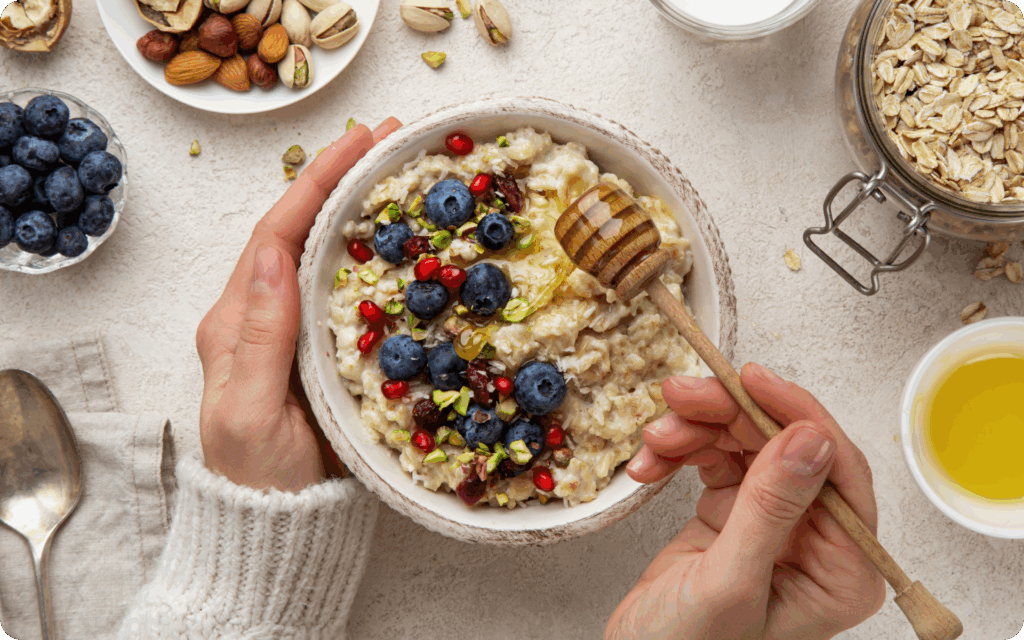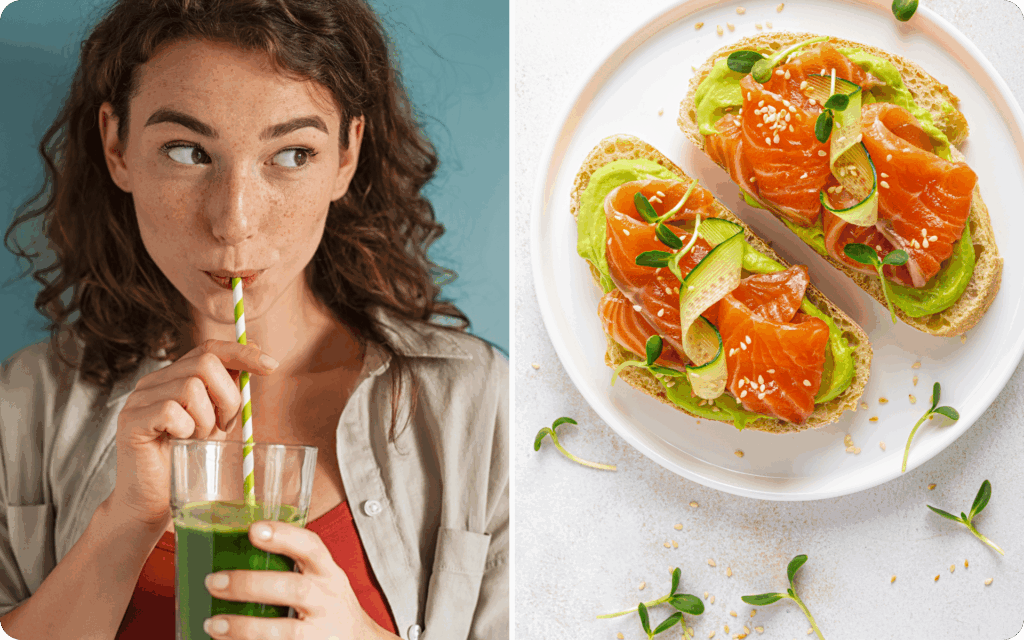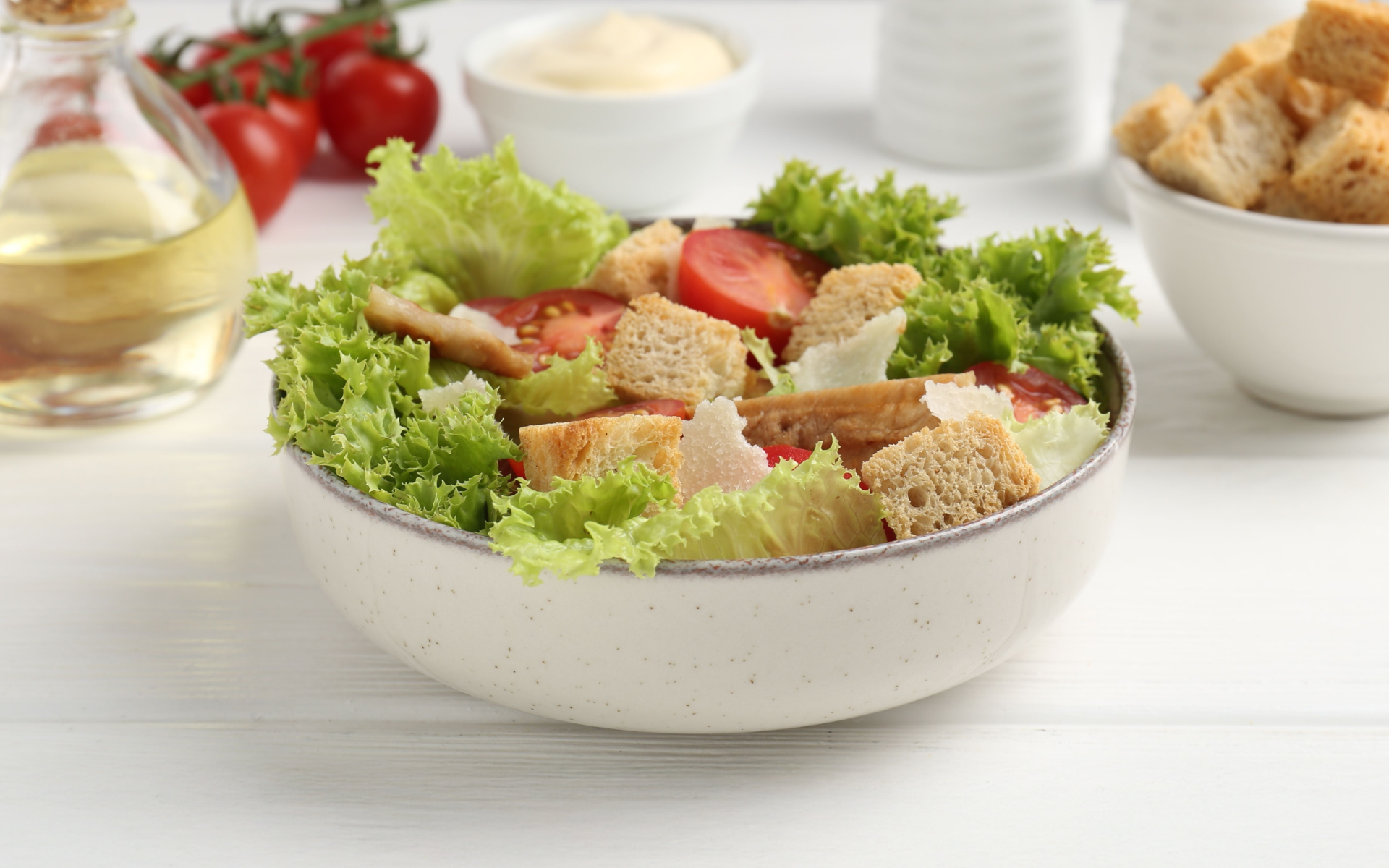Protein is the only macronutrient that the body doesn’t store in its original form for later use (1).
Unlike fats or carbohydrates, which the body can store as energy reserves, you must regularly consume protein to meet the body’s daily needs for:
- Cell repair
- Hormone production
- Immune function (2).
If the body doesn’t get enough protein from your diet, it might start to break down protein-rich tissues like muscles. Consistent protein intake is essential for everyone, regardless of age, lifestyle, or fitness goals.
But here’s the catch—not all high-protein diets are created equal.
It’s not just about quantity; it’s about choosing a variety of sources and balancing them with other nutrients.
Ahead, we share all you need to know about a 30-day high-protein meal plan, such as:
- Which high protein foods to eat
- When to eat high protein foods
- How much daily protein to aim for
Our previous post goes into great detail about the high protein foods for picky eaters.
What Is A 30 Day High Protein Meal Plan?
A 30-day high-protein meal plan focuses on incorporating high-quality protein sources into every meal, such as:
- Fish
- Eggs
- Beans
- Lentils
- Nuts
- Tofu
- Lean meats
- Dairy products
The plan emphasizes variety, ensuring you get all essential amino acids while keeping meals interesting. We designed it to be beginner-friendly, with convenient, make-ahead options like:
- Overnight oats
- Prepped protein bowls
- Batch-cooked soups to save you time
The goal is to promote balanced nutrition, pairing protein with nutrient-rich carbs, healthy fats, and plenty of vegetables for overall health and energy.
So, what is a balanced day high protein meal plan like?
The examples below can give you an idea!
Example Week Of High-Protein Meals
Day 1
- Breakfast: Greek yogurt parfait with mixed berries, chia seeds, and a drizzle of honey
- Snack: A handful of almonds and a boiled egg
- Lunch: Grilled chicken salad with avocado, cherry tomatoes, spinach, and balsamic vinaigrette
- Snack: Cottage cheese with pineapple chunks
- Dinner: Pan-seared salmon with quinoa and roasted asparagus
Day 2
- Breakfast: Scrambled eggs with sautéed spinach and whole-grain toast
- Snack: A protein bar or protein smoothie
- Lunch: Turkey and hummus wrap with mixed greens and a side of baby carrots
- Snack: Edamame or roasted chickpeas
- Dinner: Baked tofu stir-fry with brown rice and a medley of vegetables
When it comes to weight loss, progress is made by inches, not miles, so it’s much harder to track and a lot easier to give up. The BetterMe: Health Coaching app is your personal trainer, nutritionist, and support system all in one. Start using our app to stay on track and hold yourself accountable!
Day 3
- Breakfast: Overnight oats made with protein powder, almond milk, and topped with banana slices
- Snack: A handful of walnuts and a piece of string cheese
- Lunch: Grilled turkey burger served with sweet potato wedges and a side salad
- Snack: Sliced cucumbers with tzatziki
- Dinner: Grilled shrimp with zucchini noodles and a garlic-lime sauce
Day 4
- Breakfast: Veggie omelette with cheddar cheese and turkey sausage
- Snack: Sliced apple with peanut butter
- Lunch: Lentil soup with whole-grain crackers and a side of Greek yogurt
- Snack: Hard-boiled eggs and some cherry tomatoes
- Dinner: Baked chicken breast with mashed cauliflower and steamed green beans
Day 5
- Breakfast: Smoothie bowl made with spinach, frozen berries, protein powder, and almond butter
- Snack: Trail mix with almonds, walnuts, and dark chocolate pieces
- Lunch: Grilled salmon, Caesar salad with a side of whole-grain bread
- Snack: Veggie sticks with guacamole
- Dinner: Lean beef chili with black beans and a dollop of Greek yogurt
Day 6
- Breakfast: Cottage cheese pancakes with fresh strawberries and a dollop of almond butter
- Snack: A handful of roasted pistachios
- Lunch: Tuna salad with avocado scooped into bell pepper halves
- Snack: Protein shake with unsweetened almond milk
- Dinner: Roasted chicken thighs with sweet potatoes and sautéed kale
Day 7
- Breakfast: Breakfast burrito made with scrambled eggs, black beans, and salsa in a whole-wheat tortilla
- Snack: Greek yogurt with granola
- Lunch: Grilled chicken and quinoa bowl with roasted vegetables and tahini dressing
- Snack: Cottage cheese topped with sliced peaches
- Dinner: Baked white fish with wild rice and a cucumber-dill salad
Read more: Healthy Fitness Meals to Fuel Your Workout Every Day
What Foods Should I Add In A 30 Day High Protein Meal Plan?
Lean Animal Proteins
Lean animal proteins are some of the most concentrated sources of high-quality protein.
They contain all essential amino acids, making them “complete proteins (3), which are critical for muscle repair and overall health (4)
Examples:
- Lean cuts of beef (e.g., sirloin, tenderloin)
- Skinless chicken breast
- Pork tenderloin
- Turkey breast
- Eggs
Seafood
Seafood is not only protein-rich but also packed with omega-3 fatty acids, which support heart and brain health (5). It’s an excellent option for adding variety and essential nutrients to your meals.
Examples:
- Tuna
- Shrimp
- Mackerel
- Salmon
- Scallops
- Crab
- White fish (e.g., cod, haddock)
Plant-Based Proteins
Plant-based proteins are ideal for vegans, vegetarians, or anyone looking to diversify their diet (6). They go well with fiber, which promotes gut health and satiety.
Examples:
- Tofu
- Tempeh
- Edamame
- Lentils
- Chickpeas
- Black beans
Dairy Products
Dairy is an excellent source of protein, as well as calcium and vitamin D, which are essential for strong bones (7). These options are great for adding to snacks or meals.
Examples:
- Skim milk
- Greek yogurt
- Cottage cheese
- String cheese
- Low-fat ricotta
- Kefir
Nuts, Seeds, And Nut Butters
Nuts and seeds provide protein, healthy fats, fiber, and micronutrients like magnesium and zinc (8). They make for great, nutrient-dense snacks.
Examples:
- Almonds
- Walnuts
- Chia seeds
- Sunflower seeds
- Pumpkin seeds
- Peanut butter and other nut butters (unsweetened)
Whole Grains
Whole grains often contain less protein than other categories but are still valuable when paired with other proteins, offering a complete nutrient profile.
Many also deliver essential carbohydrates for sustained energy (9).
Examples:
- Oats
- Farro
- Barley
- Bulgur
- Whole wheat bread
- Quinoa (a complete plant protein)
Protein-Enriched Foods
Protein-enriched foods are everyday items that have been fortified with added protein.
These can be excellent for busy lifestyles or for individuals looking to effortlessly boost protein intake without drastically altering their diet (10).
Examples:
- Protein bread
- High-protein cereals
- Protein-enriched pasta
- Protein-packed granola
- High-protein snack bars
- Protein-enriched pancake mix
Protein Powders
Protein powders are a versatile and convenient way to increase your protein intake, especially for those with active lifestyles or limited time for meal prep (11).
You can add protein powder to smoothies, baked goods, or mix it with water or milk for a quick boost.
Examples:
- Casein protein
- Whey protein isolate
- Plant-based protein powders (e.g., pea, rice, or hemp)
- Collagen protein powder
- Egg white protein powder
- Soy protein powder
How Do You Start Following A High Protein Meal Plan?
Starting a high-protein meal plan doesn’t have to be overwhelming.
By taking small, manageable steps, you can gradually adjust your eating habits and enjoy the benefits of a balanced diet.
Here’s how to get started:
- Understand Your Protein Needs
The first step is knowing how much protein your body needs.
The Recommended Dietary Allowance (RDA) is 0.8 grams per kilogram of body weight (12); however, active individuals or those with higher fitness goals may require more.
For context, if you weigh 70 kg, your daily protein intake should be at least 56 grams.
Consider consulting a health professional to calculate your specific needs.
- High Protein Breakfast Meal Prep
Many people start their day with carbs, such as cereals or bread, but adding protein can help keep them fuller for longer (13).
Try including eggs, Greek yogurt, or protein-rich smoothies in your morning meal.
You can make a simple meal more filling by making swaps, such as peanut butter on toast instead of just butter. For more details about high protein breakfast meal prep, take a look at our prior publication.
- Choose High-Quality Protein Sources
Focus on lean, nutrient-dense protein options. These include chicken, turkey, fish, tofu, beans, lentils, eggs, and low-fat dairy. Avoid processed meats, which are often high in salt and additives, and increase the risk of certain cancers.
If you’re a vegetarian, plant-based proteins like chickpeas, quinoa, and hemp seeds are excellent choices. Even if you’re not a vegetarian, including a variety of plant- and animal-based protein sources is a good idea for everyone.
- Include Protein In Snacks
Snacking is an easy way to incorporate protein throughout your day (14).
Hard-boiled eggs, a handful of nuts, or even a piece of cheese can provide a quick protein boost. Prepping your snacks in advance makes it easier to stay on track.
- Plan And Prep Ahead
Meal prepping can save time and reduce the stress of daily cooking (15).
Dedicate one day a week to prepare proteins in bulk, like grilling chicken breasts or cooking a pot of lentils. Store them in containers for easy access during the week.
- Be Creative With Your Meals
High-protein eating doesn’t mean eating grilled chicken every day.
You can experiment with recipes, like turkey meatballs, black bean chili, or salmon patties. This variety keeps meals exciting and ensures you’re getting a mix of nutrients (14).
- Balance Protein With Other Nutrients
A high-protein plan isn’t about eating only protein.
Pair it with complex carbs, such as whole grains, healthy fats like avocado, and plenty of vegetables. Combining complex carbs with protein creates balanced meals that support your overall health.
- Start Small, Then Build Up
If significant changes feel daunting, start with minor adjustments.
Add one extra source of protein a day, such as swapping chips for hummus with vegetables. Once you’re comfortable, you can work towards including high-quality protein in every meal.
- Experiment With Protein Powders
Protein powders can be a convenient option, especially if you’re short on time (11).
Choose a high-quality product with minimal additives. Add the powder to smoothies, oats, or even baked goods.
- Track Progress And Adjust As Needed
Keep a food journal to monitor your protein intake. This tracking process helps you see what’s working and where you may need to make adjustments.
If your energy levels are low or you’re feeling too full, you may need to tweak portion sizes or meal timing.
Read more: Rainbow Diet Meal Plan: Your Daily Colorful Health Booster
Is A High Protein Diet Safe To Follow For 30 Days?
For most healthy adults, a high-protein diet is safe to follow for 30 days and beyond when done thoughtfully.
One common concern is whether high-protein diets harm the kidneys.
For individuals with healthy kidney function, research suggests that a higher protein intake does not pose a risk to their kidneys. The kidneys can filter waste from protein metabolism, and studies suggest they can handle this increased workload without damage (16).
However, for people with existing kidney disease, limiting protein intake may be necessary, as their kidneys may struggle to process the excess load.
Your doctor or a registered dietitian can help you determine the appropriate amount of protein for your individual needs.
Another myth about high-protein diets is that they negatively impact bone health by causing calcium loss.
More recent studies have debunked this misconception.
High-protein diets can improve bone health when paired with sufficient calcium and vitamin D. This is because adequate protein supports muscle mass, which, in turn, maintains bone density and reduces fracture risk (17).
Eating more protein than usual can sometimes affect digestion.
For instance, high-protein diets that lack fiber may cause constipation.
Balancing your protein intake with fiber-rich foods, such as vegetables, fruits, and whole grains, can help keep your digestion smooth (18). If you’re curious about high protein fruits, check out our earlier article.
While protein helps you feel full and supports muscle growth, eating more protein than your body needs can still lead to weight gain if you’re consuming excess calories.
Remember that protein isn’t a “free food” and should fit into your overall calorie and macronutrient goals. A low calorie high protein meal plan can help you maintain a calorie deficit to stay within your calorie limits.
What Are The Benefits Of Following A High Protein Meal Plan For 30 Days?
Following a high protein meal plan for 30 days sets the tone for long-term healthy eating habits.
Incorporating more protein into your diet can have a variety of benefits:
- You may feel fuller for longer: Protein can promote satiety (13), meaning it can help curb hunger between meals and reduce the likelihood of overeating.
This fuller feeling occurs because protein slows down digestion and affects the hormones that regulate hunger.
- You can support muscle growth and repair: Protein provides essential amino acids that your muscles need to recover and rebuild after physical activity (19).
This aspect of muscle growth and repair is especially beneficial if you engage in strength training or other forms of exercise.
- You could maintain or boost your metabolism: A higher-protein diet may help your body burn more calories at rest due to the energy required for digestion, known as the thermic effect of food (20). While the effect is modest, every bit can help with overall energy balance.
- You might preserve muscle while losing weight: If you’re in a calorie deficit to lose weight, a protein-rich diet can help prevent muscle loss (19).
This prevention helps ensure the weight you lose comes mainly from fat, not from lean body mass.
- You can support healthy hair, skin, and nails: Protein is a building block for keratin and collagen (21, 22), which are crucial for maintaining strong hair, smooth skin, and healthy nails. Incorporating adequate protein ensures these structures remain supported.
- You’re likely to stay energized longer: Protein stabilizes blood sugar levels when paired with carbohydrates and healthy fats, helping to avoid energy crashes and keep you feeling more balanced throughout the day (23).
- You improve your overall nutrient intake: High-protein foods, such as fish, eggs, beans, and nuts, are often rich in other essential nutrients, including vitamins, minerals, and healthy fats. A well-rounded high-protein diet can boost your overall nutritional quality.
- You may experience better body composition: While not guaranteed, many people find that prioritizing protein helps them lower fat mass while maintaining or increasing lean muscle. Fat loss and muscle maintenance are common goals for improving body composition (24).
- You take the opportunity to be more mindful of your meals: A high-protein meal plan encourages planning and preparing balanced meals, which can lead to better overall dietary habits. It’s a great chance to improve your relationship with food.
How Can A High Protein Meal Plan Support Weight Loss?
Helps You Feel Fuller, Longer
Research shows that a 30 day high protein meal plan for weight loss can increase satiety, which means it can help you feel full between meals.
This satisfaction happens because protein takes longer to digest and affects hunger-regulating hormones, such as ghrelin and peptide YY (13).
When you feel more satisfied after eating, you’re less likely to snack or overeat, which can lead to consuming fewer calories throughout the day.
Preserves Muscle During Weight Loss
When you’re in a calorie deficit, your body can lose muscle along with fat.
A diet rich in protein helps maintain lean muscle mass by providing the essential amino acids your body needs for repair and growth.
Doing strength training exercises also helps with this. Maintaining more muscle is vital for preserving overall strength and metabolism while losing fat (24).
The BetterMe: Health Coaching app will provide you with a host of fat-frying fitness routines that’ll scare the extra pounds away and turn your body into a masterpiece! Get your life moving in the right direction with BetterMe!
Supports A Modest Boost In Metabolism
Protein has a higher thermic effect of food (TEF) compared to fats and carbohydrates (20). TEF refers to the number of calories your body uses to digest and process food.
While this effect isn’t dramatic, it does contribute to slightly increased calorie burning after consuming protein-rich meals, helping to maintain overall energy balance.
Encourages Better Body Composition
Experts have linked high-protein diets with improved body composition, which means a higher ratio of muscle to fat. Better body composition can occur when you combine exercise with protein, which supports the development of lean muscle (24).
A better body composition often supports long-term weight management.
Helps Stabilize Energy Levels
When paired with carbohydrates, protein slows down the digestion of those carbs.
Healthy fats and fiber have a similar effect, so balanced meals that include all these nutrients can help reduce blood sugar spikes and crashes, leading to steadier energy levels (23). Consistent energy often leads to better food choices and fewer cravings for high-calorie, low-nutrient snacks.
Promotes Mindful Eating Habits
Committing to a high-protein meal plan often means intentionally choosing balanced meals and snacks. This focus encourages mindful eating, which can have a ripple effect on portion control and overall caloric intake. Over time, these healthier habits can naturally support weight management (25).
May Aid in Reducing Unhealthy Cravings
Protein-rich meals can help reduce cravings for sugary or highly processed foods by keeping you satisfied longer (13). While this isn’t a quick fix, it can make it easier to stick to a more balanced and nutritious diet over time.
The key is to include a variety of lean protein sources in your overall diet. Lean meats, such as chicken breast, turkey, and fish, are excellent options for meals. Eggs, low-fat dairy products like Greek yogurt and cottage cheese, and plant-based proteins like tofu, tempeh, and lentils are also good options. For added variety, you can include seafood, nuts, seeds, and whole grains, such as quinoa. Some simple high-protein snacks include hard-boiled eggs, Greek yogurt, cottage cheese, string cheese, edamame, and nuts. You can also reach for protein bars, nut butter with apple slices, or roasted chickpeas for other convenient options. Eating too much protein can lead to a calorie surplus, which can cause weight gain over time if you consistently consume more calories than your body needs. For individuals with pre-existing kidney issues, excessive protein intake might put additional strain on the kidneys, but this is generally not a concern for most healthy adults. Great plant-based protein choices include lentils, chickpeas, black beans, tofu, tempeh, and edamame. Other options, such as quinoa, chia seeds, almonds, pumpkin seeds, and soy-based products, are also rich in protein and excellent choices for plant-based diets.Frequently Asked Questions
What protein-rich foods are best for daily meals?
What are easy snacks with high protein?
What happens if you eat too much protein?
What are good plant-based protein sources?
The Bottom Line
A 30 day protein diet meal plan offers a structured and effective way to enhance your diet with balanced nutrition. By incorporating protein-rich foods like lean meats, dairy, plant-based options, and protein supplements, you can support muscle maintenance, manage cravings, and promote a healthy weight.
While protein plays a vital role, it’s essential to pair it with a balanced overall approach, mindful eating, and regular physical activity for sustainable results.
DISCLAIMER:
This article is intended for general informational purposes only and does not serve to address individual circumstances. It is not a substitute for professional advice or help and should not be relied on for making any kind of decision-making. Any action taken as a direct or indirect result of the information in this article is entirely at your own risk and is your sole responsibility.
BetterMe, its content staff, and its medical advisors accept no responsibility for inaccuracies, errors, misstatements, inconsistencies, or omissions and specifically disclaim any liability, loss or risk, personal, professional or otherwise, which may be incurred as a consequence, directly or indirectly, of the use and/or application of any content.
You should always seek the advice of your physician or other qualified health provider with any questions you may have regarding a medical condition or your specific situation. Never disregard professional medical advice or delay seeking it because of BetterMe content. If you suspect or think you may have a medical emergency, call your doctor.
SOURCES:
- Where is protein stored? (2025, britannica.com)
- Protein (n.d., nutritionsource.hsph.harvard.edu)
- What Are Complete Proteins? (2022, health.clevelandclinic.org)
- Protein (2018, betterhealth.vic.gov.au)
- Chapter Seven – Seafood and health: What you need to know? (2021, sciencedirect.com)
- Role of plant protein in nutrition, wellness, and health (2019, academic.oup.com)
- Dairy foods (2023, healthdirect.gov.au)
- Consumption of Nuts and Seeds and Health Outcomes Including Cardiovascular Disease, Diabetes and Metabolic Disease, Cancer, and Mortality: An Umbrella Review (2022, pmc.ncbi.nlm.nih.gov)
- Health Effects of Whole Grains: A Bibliometric Analysis (2022, mdpi.com)
- Impact of food-based fortification on nutritional outcomes and acceptability in older adults: systematic literature review (2023, frontiersin.org)
- Protein supplementation: the double-edged sword (2023, pmc.ncbi.nlm.nih.gov)
- How much protein do you need every day? (2023, health.harvard.edu)
- Revisiting the role of protein-induced satiation and satiety (2017, sciencedirect.com)
- Vary Your Protein Routine (n.d., myplate.gov)
- Meal planning is associated with food variety, diet quality and body weight status in a large sample of French adults (2017, ijbnpa.biomedcentral.com)
- CKD Diet: How much protein is the right amount? (n.d, kidney.org)
- Dietary protein is beneficial to bone health under conditions of adequate calcium intake: an update on clinical research (2014, pmc.ncbi.nlm.nih.gov)
- Fiber, Digestion, and Health (2012, health.cornell.edu)
- Dietary Protein and Muscle Mass: Translating Science to Application and Health Benefit (2019, mdpi.com)
- Effects of Varying Protein Amounts and Types on Diet-Induced Thermogenesis: A Systematic Review and Meta-Analysis (2024, sciencedirect.com)
- Structure and functions of keratin proteins in simple, stratified, keratinized and cornified epithelia (2009, pmc.ncbi.nlm.nih.gov)
- Biochemistry, Collagen Synthesis (2023, ncbi.nlm.nih.gov)
- Protein intake and energy balance (2008, sciencedirect.com)
- Effects of Dietary Protein on Body Composition in Exercising Individuals (2020, mdpi.com)
- Mindful Eating: The Art of Presence While You Eat (2017, pmc.ncbi.nlm.nih.gov)


















